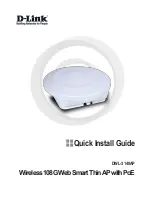
26
When the access point does not have a wired Ethernet connection to the controller (through a switch),
the radio role is called a MAP. The MAPs have a wireless connection (through the backhaul interface)
to other MAPs and finally to a RAP which has an Ethernet connection through a switch to the
controller. MAPs may also have a wired Ethernet connection to a local LAN and serve as a bridge
endpoint for that LAN (using a point-to-point or point-to-multipoint bridge connection).
Wireless Backhaul
The access point supports wireless backhaul capability using the 5-GHz radio to bridge to another
access point to reach a wired network connection to a controller as shown in
Figure 13
. The access
point connected to the wired network is considered a RAP in this configuration. The remote access
point is considered a MAP and transfers wireless client traffic to the RAP for transfer to the wired
network. Control And Provisioning of Wireless Access Points (CAPWAP) control traffic is also
transferred over this bridged link.
Figure 13
Access Point Backhaul Example
Point-to-Point Bridging
The access points can be used to extend a remote network by using the 5-GHz backhaul radio to bridge
the two network segments as shown in
Figure 14
. To support Ethernet bridging, you must enable
bridging on the controller for each access point. By default this capability is turned-off for all access
points.
Wireless client access is supported; however, if bridging between tall buildings, the 2.4-GHz wireless
coverage area may be limited and possibly not suitable for direct wireless client access.
14
8
4
38
(5.
8
Ghz)
(2.4 Ghz)
Summary of Contents for Aironet 1550 Series
Page 58: ...58 ...
















































